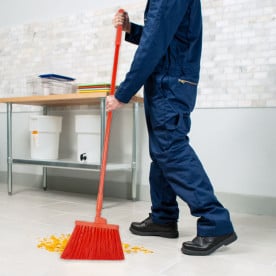Monthly Archives: April 2014

- April 23, 2014
Welcome to our exploration of wet mops for cleaning and maintenance, brought to you by Nelson-Jameson. This comprehensive guide sheds light on different yarn materials, such as Cotton, known for its absorption and cost-effectiveness, and Rayon, prized for quick absorption and resistance to mildew. Discover the advantages of Cotton/Synthetic Blend, a harmonious fusion of performance and durability. The guide also delves into the distinction between Cut-End and Looped-End Mops, offering valuable insights into their characteristics, cost considerations, and longevity. Whether you're looking to understand the nuances of yarn materials or seeking guidance on mop types, our mop buying guide equips you with essential knowledge. Additionally, explore care and maintenance tips for maximizing the lifespan of your mop heads, and learn about the benefits of Color-Coded Mops in preventing cross-contamination. Enhance your understanding of yarn varieties and elevate your cleaning practices with Nelson-Jameson's
- April 23, 2014
Welcome to a comprehensive list of safety and personnel terminology, compiled for your reference by Nelson-Jameson. This compilation covers a diverse range of terms relevant to safety in the workplace. Whether you're familiarizing yourself with industry standards like ANSI (American National Standards Institute) or exploring the characteristics of various materials such as Kevlar, Neoprene, and Nitrile, this list aims to enhance your understanding of safety-related concepts. From sole designs like Chevron and Chevron Plus to regulatory bodies like FDA (Federal Food & Drug Administration) and OSHA (Occupational Safety & Health Administration), each term is accompanied by concise explanations to facilitate clarity. Whether you're a seasoned professional or new to the realm of safety and personnel, this collection provides valuable insights into the essential terminology that underpins a safe and secure working environment.
- April 23, 2014
Streamline your waste management process by exploring our comprehensive Container & Liner Buying Guide. Selecting the right liner and container is crucial to overcoming common challenges, such as liners that are either too small, falling into the can, or too large, resulting in unnecessary expenses and wasted plastic. Our guide not only provides valuable insights into choosing the correct liner size for your container but also offers an extensive overview of various bag types.Dive into the importance of knowing your container size and understanding the applications of different plastics—Linear Low Density Polyethylene (HDPE) for smooth materials and Linear Low Density Polyethylene (LLDPE) for rough and sharp materials. Discover the significance of gauge thickness and the nuanced measurements of Mil and Micron in evaluating liner strength. Empower yourself with the knowledge contained in our guide to make informed decisions for efficient waste containment and disposal. Explore
- April 23, 2014
Delvo®Cid+ introduces a revolutionary advancement in natamycin technology, mitigating the risk of yeast and mold growth in dairy and meat products with unparalleled speed and efficacy. This breakthrough offers several advantages, including faster solubility, allowing for the rapid protection of liquid products within minutes. Delvo®Cid+ demonstrates improved suspension properties, ensuring natamycin crystals remain active and suspended for extended periods, providing enhanced protection. Highly convenient and cost-efficient, Delvo®Cid+ is a flexible, ready-to-use product with a reduced risk of application errors. With applications in cheese ripening, brine baths, and sausage casings, Delvo®Cid+ is a low-dosage, versatile solution, ensuring immediate safeguarding against contamination and optimal functionality even in challenging conditions like high salt levels.
- April 23, 2014
Navigating the vast array of pH electrodes to find the perfect fit for your application can be a daunting task, given the multitude of options available. This comprehensive selection guide serves as a valuable resource to ensure that you make the right choice when ordering a pH electrode tailored to your specific needs. Exploring the distinctions between gel-filled and refillable electrodes, glass and epoxy body designs, bulb variations, and reference chemistry, the guide offers insights into crucial features that impact electrode performance. From the ruggedness of a semi-dome design to the temperature resistance of glass bodies, each aspect is meticulously covered. The guide delves into the intricacies of reference design, emphasizing the importance of preventing contamination and presenting alternatives like double-junction or calomel electrodes. Brands such as Oakton, Pinnacle, and Thermo Scientific Orion are highlighted, offering a diverse range of electrodes with varying features
- April 23, 2014
Navigate the intricacies of hose selection with confidence by leveraging our Hose Temperature & Pressure Reference Guide. Designed to be your go-to resource, this guide empowers you to make informed decisions tailored to the specific demands of your applications. Whether you're dealing with high temperatures, variable pressure environments, or both, this comprehensive reference guide provides clarity on which hoses are equipped to handle the heat and pressure levels required to get the job done. By consulting this invaluable tool, you can streamline the selection process, ensuring that your chosen hose not only meets but exceeds the temperature and pressure thresholds crucial for optimal performance. Don't leave these critical parameters to chance—utilize our Hose Temperature & Pressure Reference Guide to make confident, well-informed choices for your diverse hose applications.
- April 23, 2014
The ratings in this chart are based on the results of laboratory tests. They reflect the relative capabilities of various Teflon, silicone, PVC and rubber hose formulations to withstand specific chemicals. NOTE: The ratings in the chart DO NOT reflect the extent to which extraction may occur or the extent to which fluids may undergo any physical changes in properties or composition as a result of coming into contact with the hose. Saint-Gobain Performance Plastics makes no representation or warranty concerning the susceptibility of any fluid to become contaminated or undergo changes in properties or composition as a result of possible extraction of hose ingredients by the fluid to be transmitted. Certain corrosives that would be destructive to the hose with prolonged exposure can be satisfactorily handled for short periods if flushed with water after use. All ratings are based on room temperature (73°F). Chemical resistance will be adversely affected by elevated temperatures.
- April 23, 2014
Explore our informative chart on filtration ratings! It covers mesh sizes, micron values, and their corresponding inches. The chart details different filtration levels, from coarse to micro, showing what each mesh size can capture. Whether it's gravel, beach sand, or other tiny particles, this chart is a handy reference for anyone interested in filtration. It's an essential tool for understanding how filtration works across various materials.
- April 23, 2014
In the realm of food processing, effective pest control stands as a paramount necessity to preempt costly shut-downs. Enter Insect-O-Cuter®, offering a meticulously designed three-phase system aimed at achieving optimal results in flying insect elimination within industrial settings. The first phase involves strategically placing units at the perimeter to intercept flying insects immediately after entry. The second phase introduces supportive Insect-O-Cutor® units along probable insect flight paths, protecting sensitive areas where contamination is a concern. The third phase places Insect-O-Cutor® units as a final interception outside crucial zones like processing and food preparation areas. The accompanying map guides the implementation of this comprehensive pest control strategy. Noteworthy considerations include the strategic placement of units in stairwells and elevators to address natural insect pathways. The provided FAQ section sheds light on various aspects, from the
- April 23, 2014
Selecting the right wheel and caster is vital for performance across various applications. Diverse wheel materials offer distinct advantages. Performa Rubber wheels, with a non-marking elastomer tread, provide a smooth, quiet, and durable ride. Duralastomer Polyurethane is a solid, durable option with a one-piece design, eliminating bonding failures. Glass Filled Nylon combines steel load capacity with high impact strength, washability, and steam cleanability. Polyolefin, light with superior impact strength, resists chemicals and protects floors. Phenolic wheels excel in quiet operation, floor protection, and resistance to impacts, chemicals, and steam. HiTech Polyurethane prevents debonding, offering chemical resistance and durability. Stainless Steel casters endure corrosive environments. Standard Duty handles up to 900 pounds with zinc-plated finish, double-hardened raceways, and versatile wheel options. General Utility casters, for medium-duty applications, handle up to 250 lbs with







